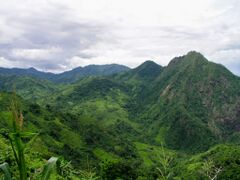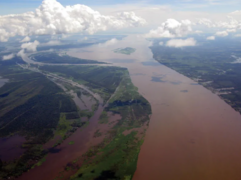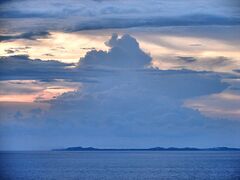Istrenya: Difference between revisions
mNo edit summary Tags: Mobile edit Mobile web edit |
mNo edit summary Tags: Mobile edit Mobile web edit |
||
| Line 56: | Line 56: | ||
|calling_code = +332 | |calling_code = +332 | ||
}} | }} | ||
'''Istrenya''', officially the '''Republic of Istrenya''', is a country in [[Crona]]. It is neighbored by [[Arcerion]] across the [[Warrington Strait]]. By area is is one of the largest Indigenous countries in South Crona, and one of the most populous. With a population of 32 million, it also is the largest Southern Cronan Indigenous country that was not nominally aligned with [[Varshan]]. The national capital is the city of [[Karaba]], which is also the nation's economic centre and the largest non-[[Occidental world|Occidental]] port in the [[Malentine Sea]], largely due to trade from across the Warrington Strait coming from Arcerion. The country is bordered by [[Tierrador]], [[Porlos]], [[Malentina]]. | '''Istrenya''', officially the '''Republic of Istrenya''', is a country in [[Crona]]. It is neighbored by [[Arcerion]] across the [[Warrington Strait]]. By area is is one of the largest Indigenous countries in South Crona, and one of the most populous. With a population of 32 million, it also is the largest Southern Cronan Indigenous country that was not nominally aligned with [[Varshan]]. The national capital is the city of [[Karaba]], which is also the nation's economic centre and the largest non-[[Occidental world|Occidental]] port in the [[Malentine Sea]], largely due to trade from across the Warrington Strait coming from Arcerion. The country is bordered by [[Tierrador]], [[Porlos]], and [[Malentina]]. | ||
Seated at the foothills and lowlands North of the South Istrenyan Mountain Range, Istrenya was largely comprised of disparate river and mountain tribes as far back as 50,000 years ago. Closer to the modern and industrial era, Occidental colonists and traders established trading posts across the Warrington Strait, which eventually became the basis in the late 1700s and early 1800s for the city of Karaba. The following century saw an expansion of trading to the nearby towns of Madara and Sumbe, in the Eastern River Basin, where the majority of the nation's economic and industrial centres remain to this day. | Seated at the foothills and lowlands North of the South Istrenyan Mountain Range, Istrenya was largely comprised of disparate river and mountain tribes as far back as 50,000 years ago. Closer to the modern and industrial era, Occidental colonists and traders established trading posts across the Warrington Strait, which eventually became the basis in the late 1700s and early 1800s for the city of Karaba. The following century saw an expansion of trading to the nearby towns of Madara and Sumbe, in the Eastern River Basin, where the majority of the nation's economic and industrial centres remain to this day. | ||
Revision as of 18:49, 6 June 2023
Republic of Istrenya | |
|---|---|
|
Flag | |
Motto: From Mountains to the Shores" | |
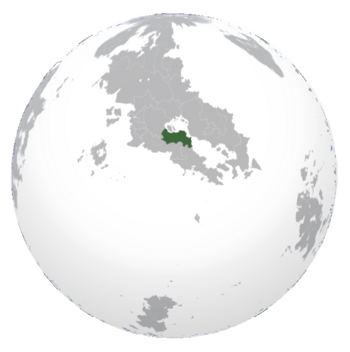 Location of Istrenya (dark green) In Crona (gray) | |
| Capital and largest city | Karaba |
| Demonym(s) | Istrenyan |
| Government | Democratic Republic |
• President | M'Kole Tysh'le |
• Vice President | L'tore Yaruba |
| National Congress | |
| Population | |
• Estimate | 32,124,217 |
| GDP (nominal) | estimate |
• Total | $525 billion |
• Per capita | 16,342.81 |
| Currency | Istrenyan Pound (Î) |
| Time zone | UTC—10:00 to UTC—08:00 |
| Mains electricity | 120 V–60 Hz |
| Driving side | right |
| Calling code | +332 |
| Internet TLD | .is |
Istrenya, officially the Republic of Istrenya, is a country in Crona. It is neighbored by Arcerion across the Warrington Strait. By area is is one of the largest Indigenous countries in South Crona, and one of the most populous. With a population of 32 million, it also is the largest Southern Cronan Indigenous country that was not nominally aligned with Varshan. The national capital is the city of Karaba, which is also the nation's economic centre and the largest non-Occidental port in the Malentine Sea, largely due to trade from across the Warrington Strait coming from Arcerion. The country is bordered by Tierrador, Porlos, and Malentina.
Seated at the foothills and lowlands North of the South Istrenyan Mountain Range, Istrenya was largely comprised of disparate river and mountain tribes as far back as 50,000 years ago. Closer to the modern and industrial era, Occidental colonists and traders established trading posts across the Warrington Strait, which eventually became the basis in the late 1700s and early 1800s for the city of Karaba. The following century saw an expansion of trading to the nearby towns of Madara and Sumbe, in the Eastern River Basin, where the majority of the nation's economic and industrial centres remain to this day.
Istrenya was never officially colonized or controlled by foreign powers, unlike many of its neighbours, owing to its poor geographic location and the favourable conditions in the Eastern Malentine where Ardmore and other Occidental countries were investing in the rapidly expanding Arcerion. Istrenya's independence was threatened during the 1956 Istrenyan Crisis where communist and socialist rebels attempted to overthrow the nation, and Arcer intervention prevented the Populist national government from being toppled and replaced by left-wing red factions based out of the Western half of Istrenya. The lasting effects of the Civil War are felt today, with the nation ethnically split between Eastern and Western cultural and tribal lines, the Eastern half regularly trades and entreats with Arcerion, whereas the West continually sees Arcerion as meddling in Indigenous affairs and violating the nation's sovereignty.
Istrenya is not particularly rich in natural resources or agriculture, mostly having a small fishing trade and some mining for raw materials in the Southern Mountains. Karaba's port is the most important Western Indigenous maritime port, servicing much of the country's needs. The next two largest cities, Madara and Mogtepeni both have disparate industries, the former being agrarian owing to its location in the Eastern River Basin, and the latter being a mining town mostly controlled by private Arcer corporations.
Istrenya's largest export is raw materials and raw minerals, over half of which are imported into Arcerion for refining and sold as finished goods. The human development of Istrenya has remained historically low throughout the 20th and 21st centuries, especially in the Western half of the nation. Istrenya has also been host to a large number of Varshani refugees after the Final War of the Deluge.
Etymology
Geography
-
The Southern Mountain Range of Istrenya.
-
The Eastern River Basin of Istrenya, which opens into the city of Karaba.
-
The Malentinian Channel the separates Istrenyan from Malentina.
-
Iraso Township in Western Istrenya.
-
Istrenyan Highlands.
-
Karaba Bay.
South Mountains
Eastern River Basin
Cities
Channels between Istrenya & Malentina
Highlands
Bay next to Karaba
History
Indigenous Tribes Period
Arrival of Traders
Lack of Colonizing
Early Modern
Istrenyan Civil War
Late Modern
2009 Rice Riots
Government
Executive
Presidential Office
Legislature
National Congress
Local governance
Tribal governments and townships
Culture
Cuisine
Eastern and Western Tribes
Demographics
Linguistic Demographics
Religious Demographics
Economy
Its bad
Like real bad
Military
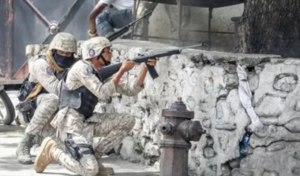
The Istrenyan military is relatively small, and has continued to shrink since the Istrenyan Civil War. The Army doubles in its role as a national gendarmerie, and lacks much of the heavy equipment, radios, and modern weaponry in order to be an effective fighting force. Concurrent to this, the military has long been plagued by corruption amongst its senior officials and been unable to procure new equipment, relying instead on international aid of intervention by Arcerion when there is issues with insurgents, subversive groups, or rebels.
Currently, the military is organized into three divisions (1st, 2nd, and 3rd) each with three infantry brigades and supporting units such as artillery, engineers, signals, and artillery. The Army lacks tanks and heavy armored fighting vehicles, instead relying on an aging fleet of armoured cars, trucks, and jeeps that in some cases pre-date the 1956 Civil War. The Army uses a variety of foreign-acquired weapons meaning that logistically it is difficult to resupply or maintain its current arsenals. All of these problems are combined with poor pay and low morale, and ethnic divisions within the Army are high as the majority of its officers and NCOs are drawn from more economically prosperous and stable Eastern Tribes, whereas the rank and file conscripts are majority Western.
The Istrenyan Air Force oeprates a few small fixed winged aircraft, mostly in the reconnaissance role, as well as light-strike. The majority of these are converted civilian aircraft, and the few fighter jets the national procured in the 1980s have fallen into a state of disrepair and have not been seen to have been airborne since the early 2000s. It possesses a few small lighter civilian-pattern helicopters for VIP transport and limited troop lift.
The Istrenyan Navy has patrol vessels and coastal cutters, and conducts mostly commerce protection, revenue services, and anti-piracy, working in conjunction with others in the Malentine Sea such as the Royal Arcer Naval Service. It has a pair of aging former Varshani frigates from the 1960s but they are often seen rusting and unable to leave port under their own power.

